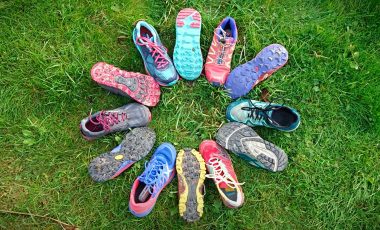There’s nothing quite like the freedom of hitting the trail and exploring in your running shoes. Trail running is such a simple pleasure that takes you further into the wilderness in less time than hiking. And unless you’re embarking on some epic multi-day trail running missions, you also don’t need to take a load of gear with you. Instead you can focus all your efforts into choosing the best trail running shoes to suit your style of running and the terrain you are exploring. And then get running!
- The best trail running shoes for women in 2024
- What to look for when choosing the best trail running shoes
For more information on the specifics of women’s trail running shoes, their design features and important properties, skip down to the bottom section on how to choose trail running shoes. Otherwise, read on to see what we think of this awesome bunch of trail running shoes that we’ve been trying out over the last year.
Summary of the best trail running shoes for women in 2024
Disclaimer: We use affiliate links and may receive a small commission on purchases.
| Product | Best for | Weight (pair US 7) | Heel to toe drop | Cost |
|---|---|---|---|---|
| Salomon Speedcross 4 | All terrain and tough trails | 520g / 18.3oz | 10mm | $$ |
| Scarpa Proton XT GTX | Wet/winter conditions, lightweight hiking, everyday wear | 600g / 21.1oz | 8mm | $$$ |
| Hoka One One Challenger ATR 3 | All terrain plus some road running | 448g / 15.8oz | 5mm | $ |
| Topo Athletic Terraventure | All terrain / easy trails | 464g / 16.4oz | 3mm | $ |
| Scarpa Spin | All terrain and tough trails | 440g / 15.5oz | 4mm | $$ |
| La Sportiva Bushido | Mountain trails | 580g / 20.4oz | 6mm | $$ |
| Altra Lone Peak 4 | All terrain | 482g / 17oz | 0mm | $$ |
| Vivobarefoot Primus Trail FG | Soft, non-rocky trails and road | 136g / 4.8oz | 0mm | $$ |
The best trail running shoes for women in 2024


Salomon Speedcross 4
The latest version of the ever-popular Salomon Speedcross trail running shoes feature unfathomably sticky soles that offer exceptional grip on almost all terrain. They perform especially well on wet on muddy ground due to their well spaced deep lugs. With the biggest heel to toe drop of all the shoes we’ve tried, these are the best trail running shoes for those trying to ease away from heel striking. Plus, the highly cushioned midsole and fitted support of the shoes can turn even the most laborious plodders into veritable bouncers! The speed lacing system is highly appealing to those who don’t need to customise the fit with specific lacing systems, and the lightweight uppers flush water through with expert efficiency.
Pros
- Deep lugs
- Exception grip, especially in the mud
- Loads of cushioning and bounciness
- Large heel to toe drop
Cons
- Speed lacing doesn’t suit everyone
- Narrow fit
Find the latest price on:
Amazon | REI | Backcountry
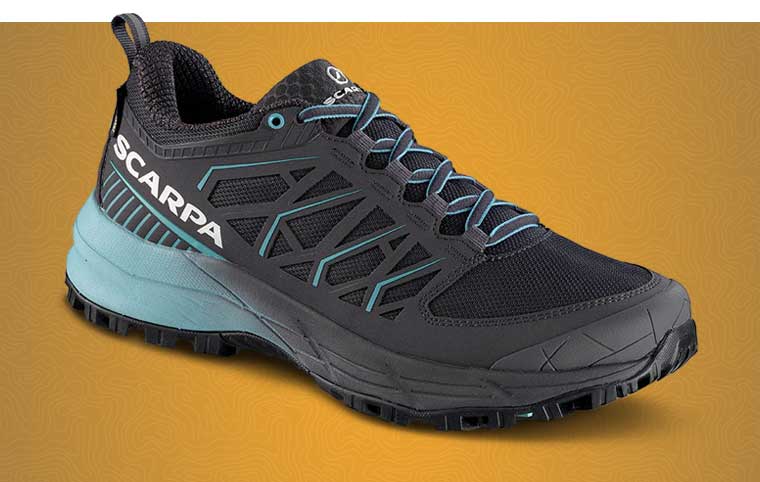

Scarpa Proton XT GTX Trail Shoes
Boasting a breathable and waterproof Gore-Tex membrane, the Scarpa Proton XT GTX Trail Shoes are the only waterproof trail running shoes on our list. Weighing in at around 600g per pair, they are also the heaviest. Though this is less appealing for light-footed off-road scampering, the slightly heavier weight and solid structure adds a degree of versatility not offered by the other options on our list. They double as excellent walking shoes on varied terrain and provide protection from the cold and wet during inclement winter trail runs. Additionally, their casual style means that they are also a good option for everyday wear and travelling.
Vibram soles with deep lug patterns provide confidence and grip on technical trails. Plus, like the Scarpa Spin’s, there is even a small pocket to stow away your laces!
For more information read ourfull review of the Scarpa Proton XT GTX Trail Shoes.
Pros
- Fully waterproof
- Good support at the ankle
- Highly versatile
- Good for winter running
Cons
- Sizing can be a bit tricky
- Not as much cushioning as other options on the list
- Not much support through the arches
Find the latest price on:
Scarpa
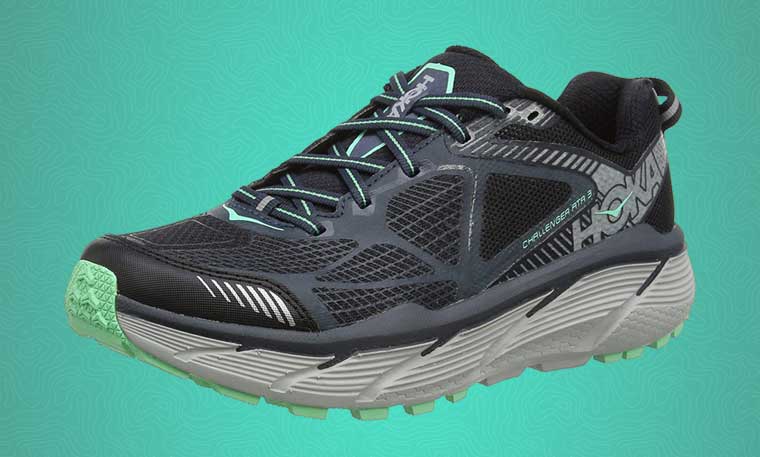

Hoka One One Challenger ATR 3
The distinctive design of the lightweight Hoka One One Challenger ATR 3 trail running shoes can feel a little strange if you are used to wearing a more minimalist shoe. But after a few outings you’ll soon start to love their bumper-like, luxurious cushioning. And because their heel to toe drop is relatively small (5mm), they do a great job at promoting a neutral gait, despite the oversized cushioning. The grip is surprisingly good on almost all terrain, including wet rock, mud and loose dirt. However, in wet conditions they struggle to drain water as effectively as the Speedcross. The Challengers are the best trail running shoes if you are looking for mega comfortable, versatile shoes, and are a superb option for road running as well as trail running.
Pros
- Very comfortable
- Good for road running as well as off-road trails
- Good grip on varied terrain
- Lightweight
Cons
- The bumper-like cushioning can take a bit of getting used to
- Don’t drain as well as other options
Find the latest price on:
Amazon | REI | Backcountry
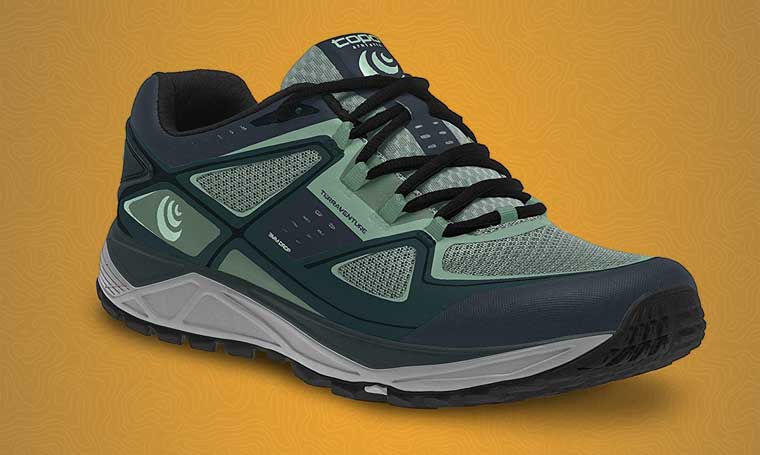

Topo Athletic Terraventure
For those looking to transition towards barefoot running, or trail running shoes with a zero-drop design will love the Topo Athletic Terraventure. With only a small 3mm heel to toe drop and a very spacious toe box to splay those tootsies, these minimalist trail running shoes encourage natural and instinctive movement in a similar way to the Altra Lone Peaks. Their modest cushioning provides just enough comfort for long days on the trail without being overly sensitive on uncomfortable terrain. They grip offered by other options when on muddy trails or wet rock due to their close tread pattern. But on dry, loose terrain they keep up with the likes of Salomons.
For more details read our full review of the Topo Athletic Terraventure trail running shoes.
Pros
- A great transition shoe to barefoot running
- Very roomy toe box
- Comfortable
Cons
- Lacks good grip in mud and wet rock
Find the latest price on:
Amazon | REI | Backcountry
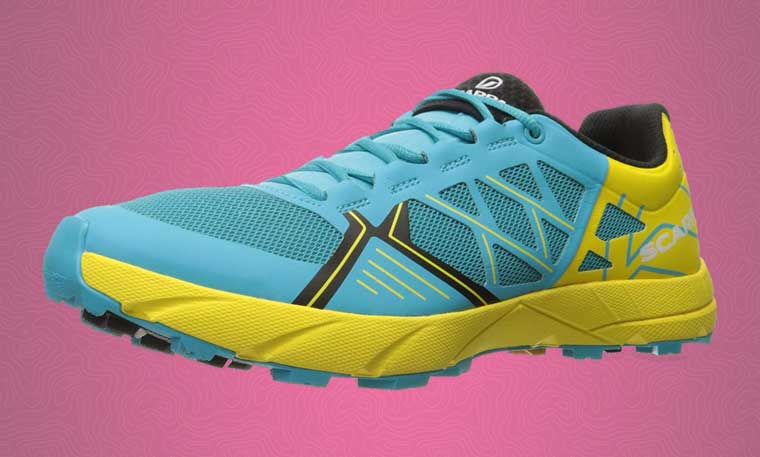

Scarpa Spin
The Scarpa Spins are a high performance trail running shoe that are ideal for pushing your speed on the trail. In terms of fit and grip, the Spins are closest to the Speedcross, minus the instantly bouncy feel. But where they lack in bounciness, they make up for in their sensitivity through the front of the foot making them ideal for those who prefer to feel their way through race day! They also have a little more space in the toe box than the Salomons and their aggressive lugs don’t wear down so quickly. You’ll be speeding your way up the steep ascents powered by the mega grippy Litebase Vibram sole. And flying back down them with confidence. Responsive, durable and comfortable, we love casual trail runs in the Spins, as well as pushing it on the harder stuff.
For more details read our full review of the Scarpa Spin trail running shoes.
Pros
- Very lightweight
- Exceptionally grippy on all terrain
- Good sensitivity
Cons
- Not as much support through the arches as other options
Find the latest price on:
Amazon | REI
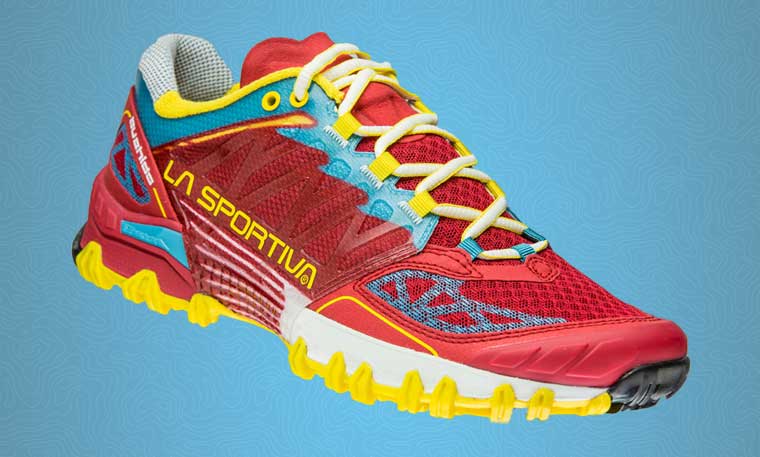

La Sportiva Bushido
Designed for competitive sky running, the La Sportiva Bushido take trail running shoe technology to the next level, literally! Their Dual mix FriXion XT outsole means that they are exceptionally grippy on dry, steep, rocky terrain. And the EVA and Rock-Guard midsole provides the kind of protection, support and stability one would expect from a climbing approach shoe, but without the associated weight. They feature a 6mm heel to toe drop with a supportive and well cushioned heel that pairs very nicely with modest cushioning at the front of the foot for great feel. The Bushido’s are the most stiff of all of the shoes on our list and are the most technical in terms of their speed and performance on inclines. They are ideal for mountain runners, but not as comfortable as a shoe like the Hoka One One Challengers in terms of versatility and comfort.
For more details read our full review of the La Sportiva Bushido trail running shoes.
Pros
- Exceptional grip
- Excellent support and stability
Cons
- Not the best for general use
Find the latest price at:
La Sportiva | Amazon | REI | Backcountry
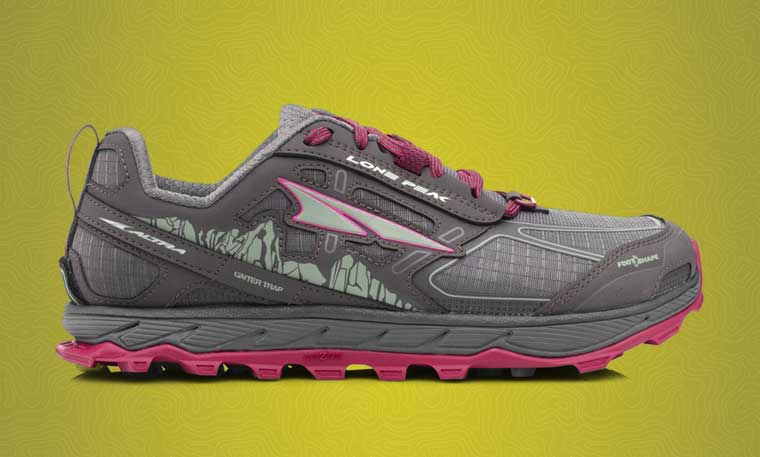

Altra Lone Peak 4
The newest version of Altra’s Lone Peak range features some innovative improvements on previous versions, mainly focused around the outsole. This is lighter, with multi-directional lugs and is supported by a new Stoneguard that provides flexible protection through the sole of the foot. The toe box of the Lone Peak is vast, even more-so than the Terraventures, and it can feel overly too roomy to start with. But if you like to splay your toes and really feel the trail through natural movement then you’ll love the style of these trail runners. They feature generous cushioning right across the sole, as well as a zero-drop design which also promotes a more instinctive and natural running style (that will seriously work your calves if you’re not used to it!).
Grip-wise, they deal with dry rock, loose dirt and wet mud equally well resulting in elevated confidence on the big descents.
For more details read our full review of the Altra Lone Peak 4 trail running shoes.
Pros
- Very roomy toe box
- Excellent grip
- Plush cushioning
Cons
- Zero drop needs an adjustment period if you’re not used to them
- Roomy toe box may not be for everyone
Find the latest price on:
Amazon | REI | Backcountry
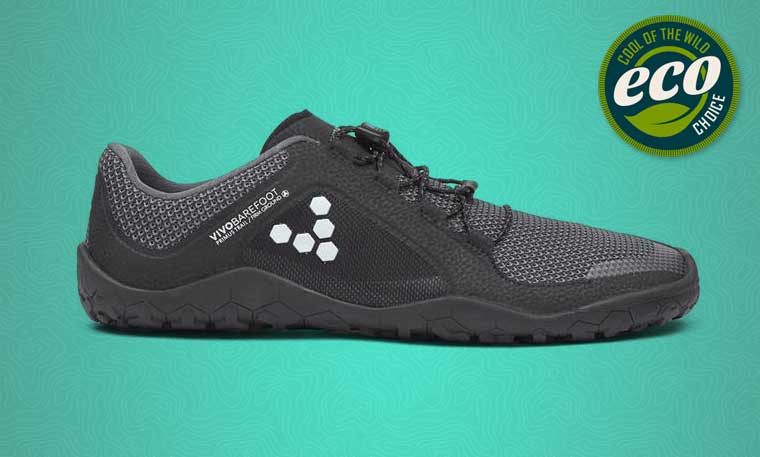

Vivobarefoot Primus Trail FG
Eco-conscious: The upper mesh is made from recycled PET
For those looking to take their running missions in a different direction, these Vivobarefoot Primus Trail FG Shoes are most certainly worth considering. Don’t expect to feel at home in them immediately, though; they take some getting used to if zero drop shoes are new to you. And if you predominantly run on rocking and stoney trails then you may want to avoid these shoes. However, if your trails take you along soft, woodland paths, over open grassland, or even on hard-packed mud tracks, the sticky rubber soles provide just enough protection underfoot.
The main benefits of opting for these minimalist trail running shoes are for maximum feel on the trail and to get your body and feet back to working the way they were designed to work: naturally, with minimal support and maximum flexibility. They are also incredibly lightweight making you really feel like you’re running barefoot!
They’re certainly not for everyone. But if you can get past the initial discomfort and calf overload, barefoot shoes can be excellent at helping fix joint problems (although you should seek professional advice about this is you are experiencing problems).
For a more cushioned option, or to work your way towards barefoot shoes, try out the Altra’s which are also a zero drop trail running shoe.
For more details read our full review of the Vivobarefoot Primus Trail FG trail running shoes.
Pros
- Mega lightwieght
- Good grip on dry terrain
- Wide toe box
Cons
- They take some getting used to if you’ve never worn barefoot-style shoes before
- The thin soles means you can feel every rock and stone on the trail!
Find the latest price on:
Amazon | Vivobarefoot
How to choose trail running shoes
Grip
One of the most important features of the best trail running shoes is the grip and traction of the he outsole (bottom). Sticky rubber and deep lugs are key features of high traction shoes. But it’s also important to consider the spacing of the lugs. Shoes with widely spaced lugs like the Salomon Speedcross, shed mud more efficiently than lugs that are close together. Obviously this isn’t of much importance if you frequent dry, rocky trails.
Stability
Another key factor to consider is the level of stability. In general, shoes that are stiff through the sole, like the La Sportiva Bushido’s, provide greater stability than super flexible trail runners. In some shoes this is down to an inserted piece of plastic or nylon that sits between the midsole and the outsole. Other factors that affect stability are the stiffness of the uppers, especially in the ankle and heel area. And also the degree of support in the arch of the shoe.
Protection
When you’re running on unpredictable and uneven terrain for miles on end, it’s important that your shoes protect your feet, as well as helping you fly! The best trail running shoes should provide a degree of protection at the toes, even if this is just an extension of the outsole curving up around the front of the toes. Some shoes take this a step further with added layers of durable material, like the sandpaper-like sections on the Altra Lone Peaks.
As well as toe protection, most trail running shoes have rock plates inserted between the midsole and outsole. These vary from shoe to shoe and the level of protection you opt for depends on how much you want to ‘feel’ the trail as you run. Sensitivity through the sole can be positive on technical trails. But repeated leaping onto sharp rocks and roots without much protection through the sole can also be a negative!
Heel to toe drop
This is the height difference between the heel and toe of a trail running shoe. It varies greatly from shoe to shoe and can have a huge affect on your running technique.
if you chop from It is not advised to change from
Shoes with a large heel to toe drop, like the Salomon Speedcross (10mm), are designed to steer wearers towards mid or forefoot striking. High performance trail running shoes for alpine and mountain running often have a higher drop.
Zero-drop designs mean that there is no height difference between the heel and toe of the shoe. This style of trail shoe promotes a natural running style and are good for those wanting to transition towards barefoot running.
Most trail running shoes for moderate terrain and all round use tend to have a medium heel to toe drop (somewhere around 5mm).
The level of heel to toe drop you choose largely comes down to personal preference, what you are used to and what you find comfortable. Despite the small degrees of differences in drop height between different shoes, it’s not advised to jump from one to another and assume there won’t be teething problems. Different muscles are used for each height, so start off on short runs if you are making a change.
Cushioning
The level of cushioning provided by the best trail running shoes varies hugely. Choosing a highly cushioned shoe, like the Hoka One One Challengers, is an appealing option for those looking for some shock-absorption for their joints. Lots of cushioning is also a good idea if you frequent hard-packed, unforgiving trails.
If you prefer to feel the trail, then opt for a shoe with moderate to light cushioning. Or choose a shoe like the Scarpa Spin’s that combine a cushioned heel with lighter cushioning at the forefoot for better sensitivity on the trail.
Weight
For those tackling long distance trail runs, or those wanting to push their speed on the trail, low weight trail running shoes are essential. And even if you like to plod along for relatively short distances, heavy shoes will soon start to grind you down.
Thankfully, trail running shoe technology is advancing rapidly with each new season of stock. This means most high end shoes are mega lightweight without having to sacrifice on performance.
Of course there are minimalist trail shoe designs that are insanely lightweight and do compromise on certain performance features. Just as there are much heavier options that are feature heavy too.
So, choosing something with a balance of low(ish) weight and high performance is the probably the best way to go, unless you have a very specific trail running need!
Water management
Most trail running shoes aren’t waterproof. That’s not to say they don’t exist; there are plenty of options out there with GoreTex breathable membranes that keep the water out. One of the issues with this, however, is the lack of drainage. If (and when) water gets into the tops of your shoes during river crossings or in snow, it can’t get out again if there is a waterproof membrane. The result is very uncomfortable running and mushy feet.
So, many trail runners opt for shoes that aren’t waterproof (this also makes them more breathable), so that water can flush out easily. And to keep their tootsies dry (especially good in cold conditions) they wear waterproof socks or gaiters.
Laces
There are a couple of different lacing options to choose from when looking at trail running shoes:
- Speed laces — these are great if you don’t require a customised fit. They tend to stay put and don’t loosen as you run.
- Regular laces — these are the better option if you need to tighten up in specific spots. They are the most common style of lacing.
That’s a lot to take in, especially is you are new to off-road running. So if in doubt, the best trail running shoes for you are the ones that are the most comfortable. You can always upgrade further down the line. But staying comfortable from the get-go will make you fall in love with the trail, and give you opportunity to find your style and preferences with time.
Happy running, happy trail blazers!


